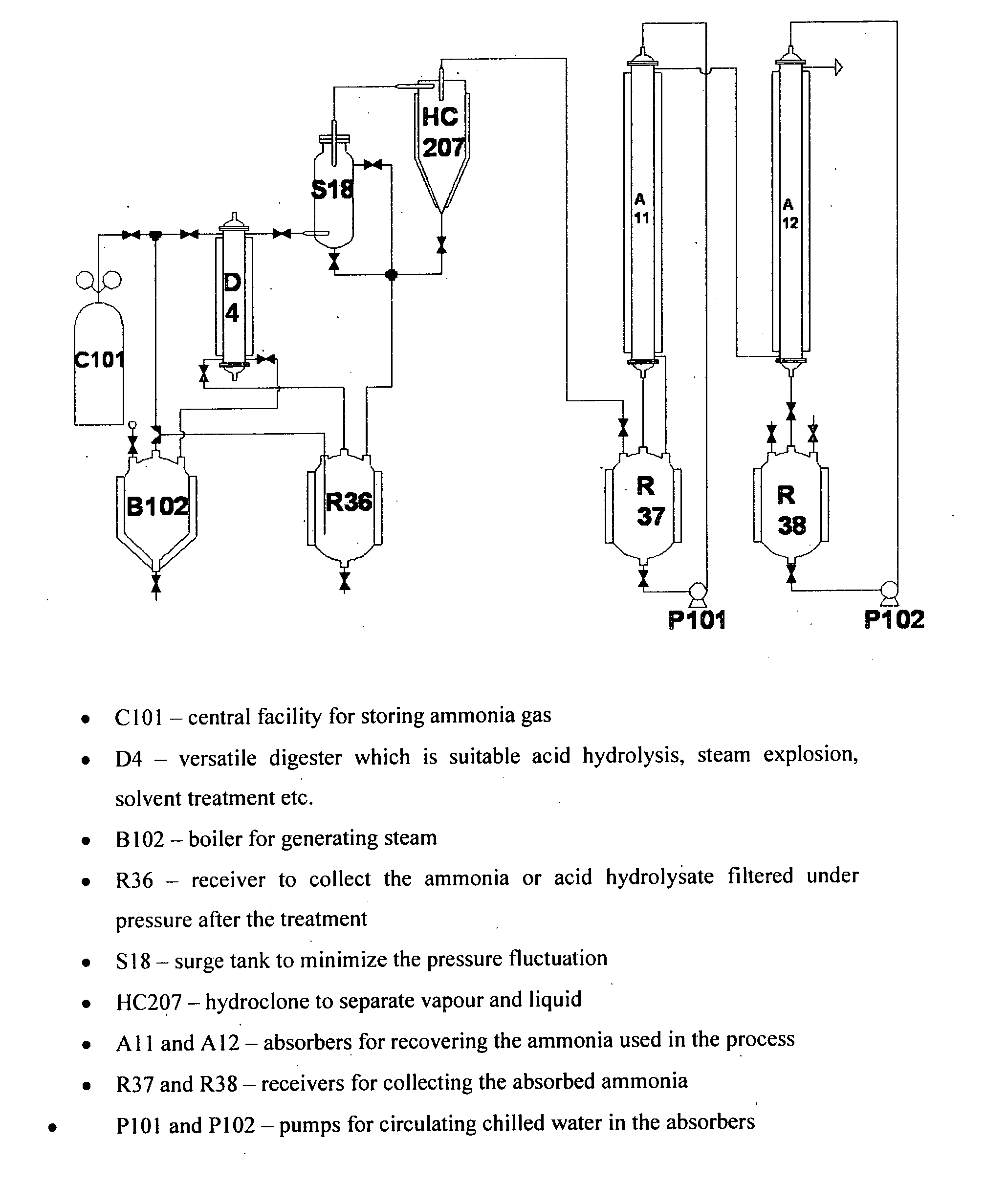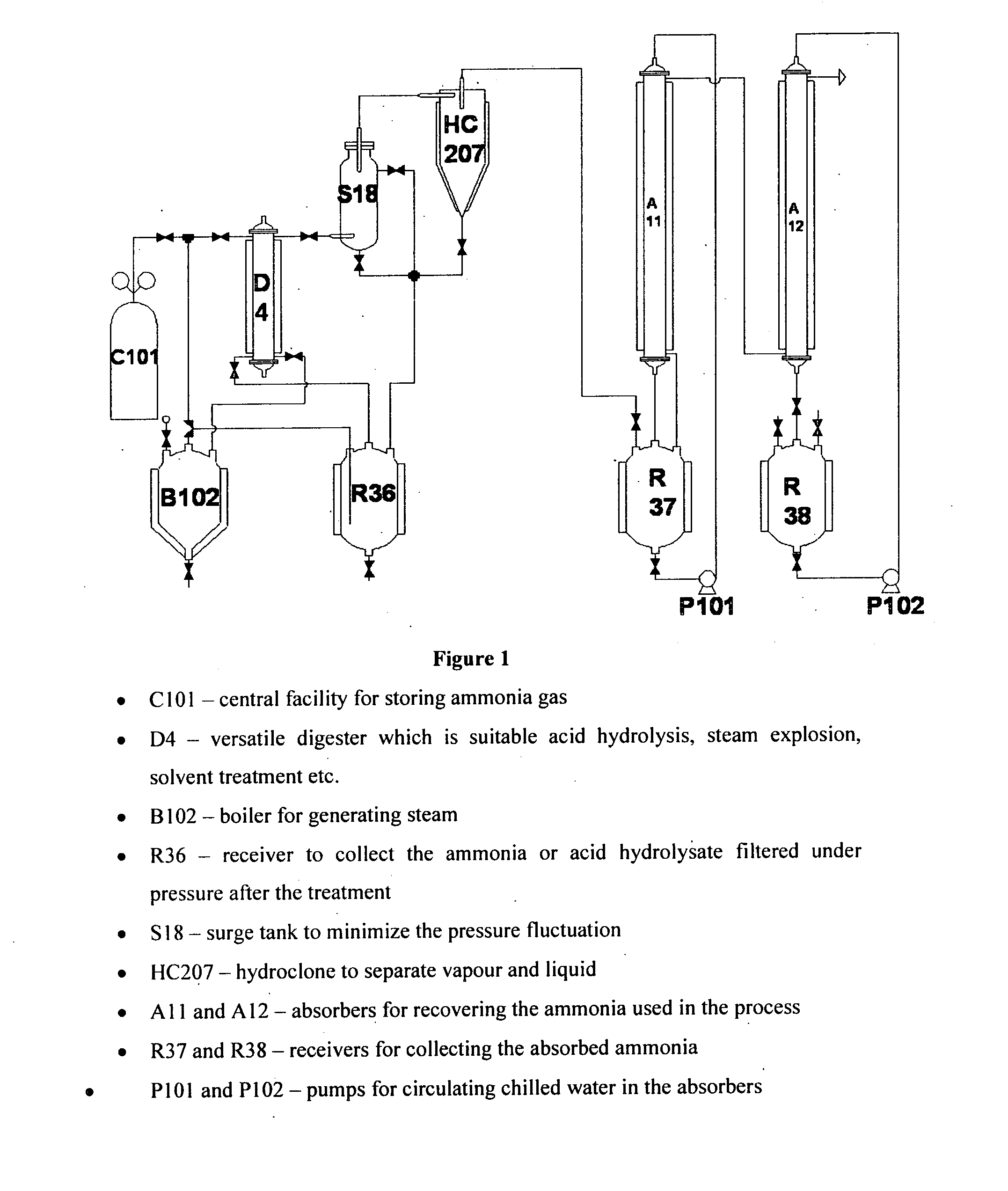Process for separating biomass components
- Summary
- Abstract
- Description
- Claims
- Application Information
AI Technical Summary
Benefits of technology
Problems solved by technology
Method used
Image
Examples
example 1
Effect of Different Ammonia Concentrations on Sweet Sorghum Bagasse with Increased Treatment Time
[0067]About 100 g sweet sorghum bagasse was loaded in the pre-treatment reactor. The particle size of the bagasse used was in the range of 0.5-1 mm. To this biomass different concentration of ammonia either 10% or 20% or 30% were added. The amount of different ammonia solutions added was such as to give a final solid concentration of 15%. The reactor then heated to attain of pressure of 7.5 Bar in all the cases. The temperatures attained for 10, 20 and 30% ammonia were 140, 120 and 90° C. respectively. Direct steam injection employed to heat the reactor. The contents in the reactor held at the said conditions for an extended time of 30 min. After the holding time the contents filtered under pressure and the hydrolysate collected in a receiver. The hydrolysates / filtrates analyzed for cellulose and hemicellulose present by sugar analysis. The residue obtained analyzed for cellulose, hemice...
example 2
Sulphuric Acid Treatment at Higher Temperatures
[0069]The biomass (100 g), sweet sorghum bagasse of 0.5-1 mm particle size, was loaded in the pre-treatment reactor to this 1% (v / v) sulphuric acid was added to get a final concentration of 15%. The contents in the reactor heated to 140° C. or 160° C. using direct steam injection. The contents held at the said temperatures for 10 min. After that, the contents filtered under pressure to get the acid hydrolysate and residue. The hydrolysates / filtrates analyzed for cellulose and hemicellulose present by sugar analysis. The residue obtained analyzed for cellulose, hemicellulose and lignin. The results are given in table 2.
[0070]Table 2 gives the % removal of cellulose, hemicellulose and lignin in the pretreated residues when compared to the starting material.
TABLE 2% removal of biomass componentsTemperatureCelluloseHemicelluloseLignin140° C.35.56%59.30%21.40%160° C.32.24%81.19%29.20%
example 3
Two-Stage Process for the Separation of Biomass Components
[0071]In the pre-treatment reactor 100 g of sweet sorghum bagasse of size 0.5-1 mm was loaded. To this 30% ammonia solution added to give a final solid concentration of 15%. The contents of the reactor then heated to achieve a temperature of 120° C. (the corresponding pressure at that temperature was 15 Bar) by direct steam injection. The contents held at that temperature for 10 min and then filtered under pressure. The hydrolysate collected in the receiver.
[0072]After the under pressure filtration process the residue was washed with steam to remove the residual ammonia and then the reactor was cooled by passing cold water in the jacket. After cooling the reactor, 1% sulphuric acid pumped in to achieve a solid concentration of 15%. The contents heated to 140° C. or 160° C. by direct steam injection. The contents held at the said temperature for 10 min and then filtered under pressure. The acid hydrolysate collected separately...
PUM
| Property | Measurement | Unit |
|---|---|---|
| Temperature | aaaaa | aaaaa |
| Fraction | aaaaa | aaaaa |
| Fraction | aaaaa | aaaaa |
Abstract
Description
Claims
Application Information
 Login to View More
Login to View More - R&D
- Intellectual Property
- Life Sciences
- Materials
- Tech Scout
- Unparalleled Data Quality
- Higher Quality Content
- 60% Fewer Hallucinations
Browse by: Latest US Patents, China's latest patents, Technical Efficacy Thesaurus, Application Domain, Technology Topic, Popular Technical Reports.
© 2025 PatSnap. All rights reserved.Legal|Privacy policy|Modern Slavery Act Transparency Statement|Sitemap|About US| Contact US: help@patsnap.com


